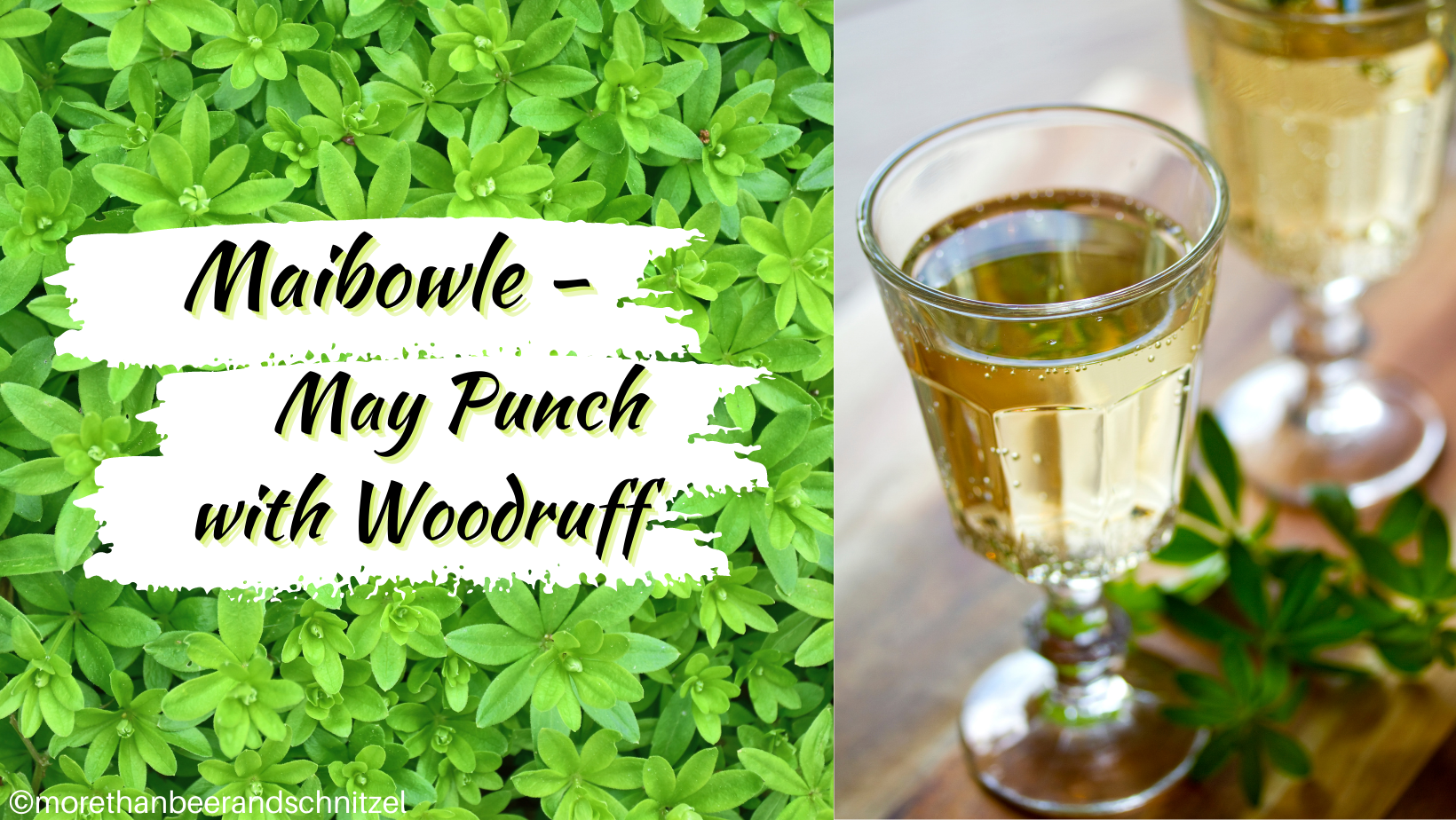Maibowle, Maitrank, Maiwein, Waldmeisterbowle, … May Punch or May Wine in English … this delicious green drink goes by many different names and comes in countless variations: with or without alcohol, with fruit, with mint. But all versions have one thing in common: Waldmeister! In English, that’s sweet woodruff or wild baby’s breath.

What is Waldmeister?
Waldmeister literally translates to “forest master” but has many different regional names: Wohlriechendes Labkraut, Maikraut, Waldmeier, Mösch, Zehrkraut, Waldmännlein, Halskräutlein, Sternleberkraut , Gliedekraut to name a few. Where exactly Waldmeister got its name is not clear.
Waldmeister is called sweet woodruff, wild baby’s breath and galium odoratum. It normally blooms from April to June. For the May Punch you want to pick the woodruff before it blooms and let it dry or wilt for a day or two. The typical Waldmeister flavor comes from cumarin and it is at its lowest concentration in the leaves before blooming. Once the leaves are drying and wilting, the cumarin will grow stronger.
Woodruff has long been used as a medicinal herb and is already mentioned in books from the Middle Ages. It was used to strengthen the heart, on infected wounds and boils, and when having liver problems. Woodruff is said to be anti-inflammatory, vasodilating, and loosen cramps.
In the late 19th century, Sebastian Kneipp, the so-called water doctor, incorporated woodruff into his Kneipp-Kur using it for headaches, toothaches, coughs, wounds, chest pain and as a calming remedy.
While woodruff is not toxic, a high concentration of cumarin can lead to severe headaches, vertigo, and nausea. That’s why it’s important to use early woodruff (before it starts flowering) and to not use more than 3-5 gr of woodruff per liter.
How to Make Maibowle
As the name suggests, Maibowle or May Punch is made and drunk in May, traditionally on May 1st. Since woodruff starts blooming early in spring and you want to harvest the leaves before it starts to flower, the earlier you pick your leaves the better. Though you can also clip the little white flowers off if the Waldmeister is already in bloom.
Once you collected your leaves, either from the forest or your garden, around 10 sprigs, make sure you let them dry for a day or two. The cumarin will developed its typical aroma in that time.
As I said there many different recipes for the Waldmeisterbowle but generally speaking you need a ratio of 2:1 of white wine and sparkling wine/champagne.
Ingredients:
- 1.5 liters of dry white wine
- 0.75 liters of medium-dry champagne, prosecco or sparkling wine
- 10 sprigs of woodruff (that should give you roughly 3-5 gr per liter) or woodruff syrup
- optional: sugar, lime juice, orange slices, strawberries, mint, ice
To make it with less alcohol substitute the prosecco with sparkling water. For Kinderbowle (punch for children), use apple juice and sparkling water.
Start by filling your serving bowl or large pitcher with dry white wine. Take your sprigs of woodruff, make a little bundle and then tie them to a stirring spoon that you lay across your pitcher or bowl. The leaves of the woodruff should be hanging in the wine while the stems should not be submerged because they have a bitter flavor that you don’t want in your wine. Remove the sprigs after around 30 minute and add the (cold) champagne.
If you use Waldmeister syrup, you mix the white wine and the syrup (around 0.4 l), and then add sparkling wine or water.
The advantage of using syrup, bought or homemade, is that you can enjoy a glass of Maibowle not just in May but all through the summer. There are also many recipes for cakes and pudding that you can make (see under Sources and Resources).

Here are instructions for a Waldmeisterbowle, it’s in German but basically uses the same recipe as I listed above. I also made a youtube playlist with interesting videos about Waldmeister, how to make the Maibowle and woodruff syrup.
History of Maibowle and Waldmeister
As I mentioned before Waldmeister has been used for hundreds of years. Vikings added it to their beer while doctors, healers, and monks appreciated its medicinal properties.
A recipe for Maibowle was mentioned by Benedict monk Wandalbertus of the monastery Prüm in the year 854. The drink didn’t only contain woodruff but also leaves of blackcurrant (schwarze Johannisbeere) and ground ivy (Gundelrebe). Wandalbertus also mentions that the drink helps strengthen the heart and liver.
Supposedly, woodruff also got rid of demonic powers and if you wanted scare off witches, you could mix woodruff with amber, and mosquito plant to do so. The connection between woodruff, witches and May can also be seen in the Walpurgisnacht which is the night from April 30th to May 1st. That date is called Beltane and is the spring equivalent to Halloween. The witches would meet on that night, on the Blocksberg (coll. Brocken) in the Harz mountains. Though obviously, they wouldn’t use the woodruff to scare each other away. I also feel I should say that Walburga after whom the night is named wasn’t a witch at all but a saint who was canonized on May 1st.
The Waldmeisterbowle how we know it today might have not been around since the Middle Ages but judging by the following painting it was definitely part of the German culture a good hundred years ago.


Sources and Resources
- Wiki – Maibowle
- Wiki – Waldmeister
- Kräuterbuch
- YouTube – American tries Waldmeister
- Maibowle Pound Cake
- Rezepte mit Waldmeister
- YouTube Playlist Waldmesiter
- Pinterest Board Waldmeister, Rezepte



